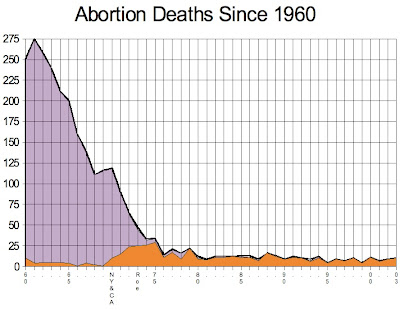Abortion rights activists would claim that, as tragic as Danielle's death was, even more women would have been dying were abortion still illegal in New York. As you can see from the graph below, this theory doesn't hold. Abortion deaths were falling dramatically long before legalization. This steep fall had been in place for decades. To argue that legalization lowered abortion mortality simply isn't supported by the data.

On April 2, 1924, 26-year-old homemaker Mary Whitney underwent an abortion at the Chicago office of Dr. Lou E. Davis. On May 17, Mary died at St. Mary's Hospital of complications of that abortion. Dr. Davis was held by the coroner on May 19. Davis was also implicated in the abortion deaths of Anna Adler and Esther V. Wahlstrom. The permissive attitude toward abortion in Chicago might have played a role in why Davis was free to commit so many lethal abortions.
On May 17, 1919, 27-year-old nurse Gertrude Schaefer, a widow, died at Chicago's Wesley Hospital (pictured) from septicemia caused by an abortion perpetrated by an unidentified person. Since Chicago abortions tended to be perpetrated by doctors and midwives, it's likely that one of them was instrumental in this young woman's death.
On May 17, 1904, Miss Margaret McCarthy died in Chicago's Mary Thompson Hospital from an illegal abortion performed some days earlier at an unknown location. Mrs. Gertrude Plenz was arrested on May 21 for the death, and Benjamin Frederick, a boiler inspector, arrested for complicity. Both Plenz and Frederick were held by Coroner's Jury. Plenz is listed as an unskilled laborer in this arrest, but when she was arrested for the abortion death of Sarah Cushing, her profession was given as midwife, and the fatal abortion was listed as having been performed at a hospital. Margaret's abortion was unusual in that it was performed by a midwife, rather than by a doctor, as was the case with perhaps 90% of criminal abortions.
Note, please, that with general public health issues such as doctors not using proper aseptic techniques, lack of access to blood transfusions and antibiotics, and overall poor health to begin with, there was likely little difference between the performance of a legal abortion and illegal practice, and the aftercare for either type of abortion was probably equally unlikely to do the woman much, if any, good.
For more on pre-legalization abortion, see The Bad Old Days of Abortion
No comments:
Post a Comment